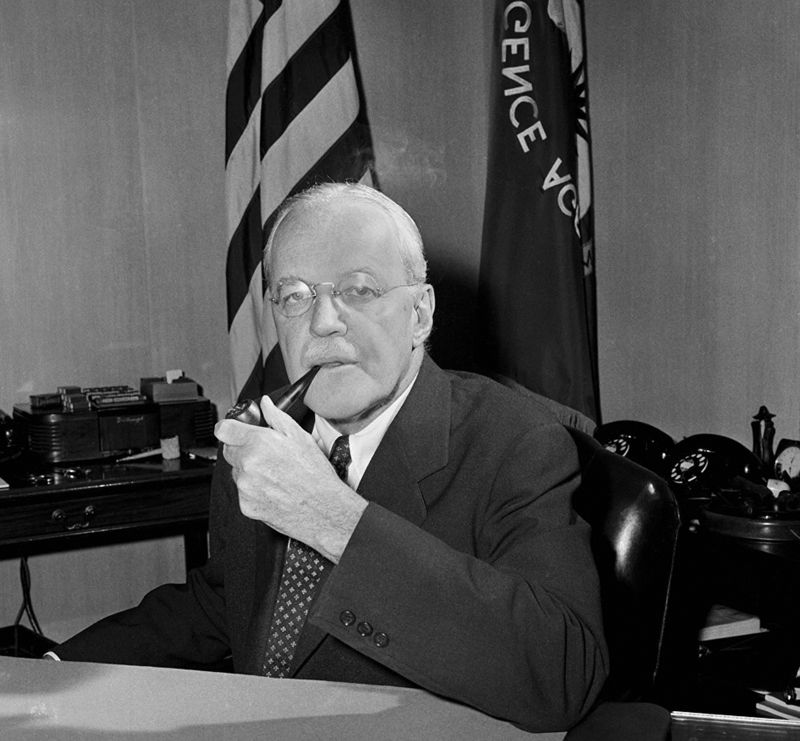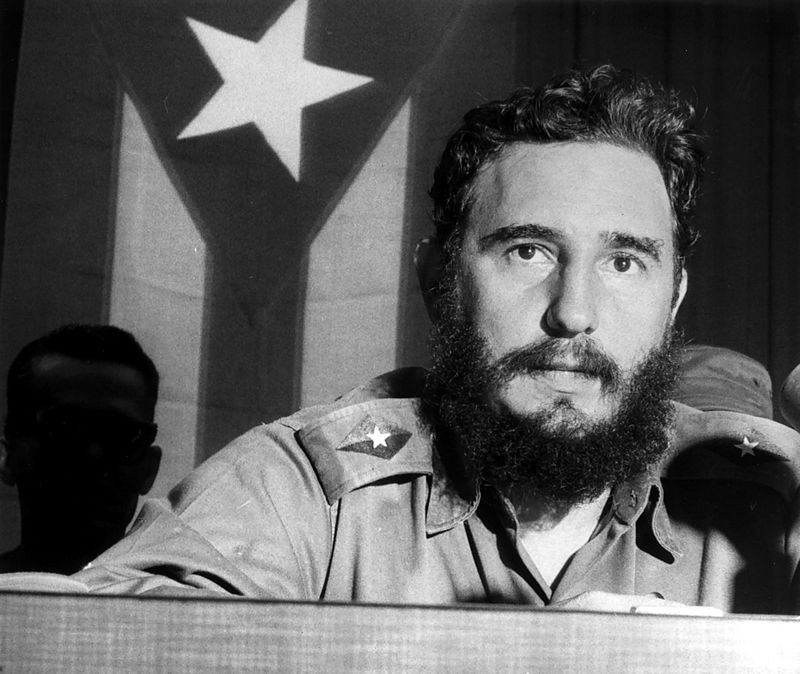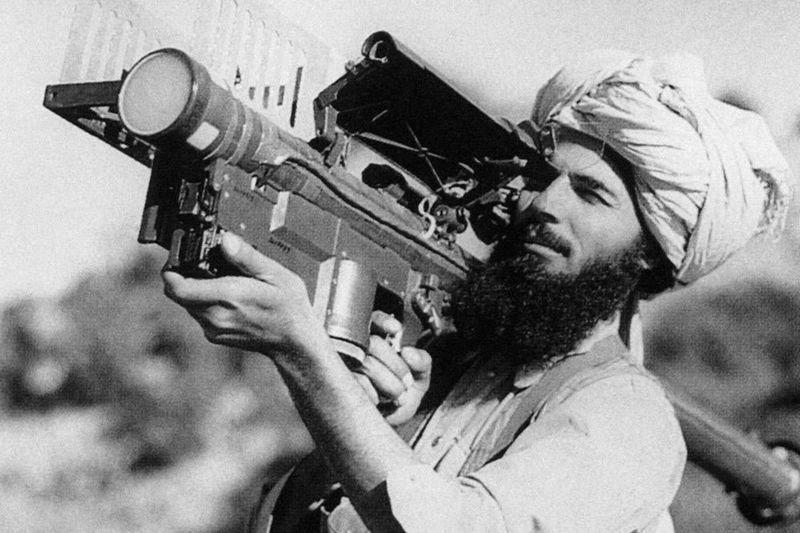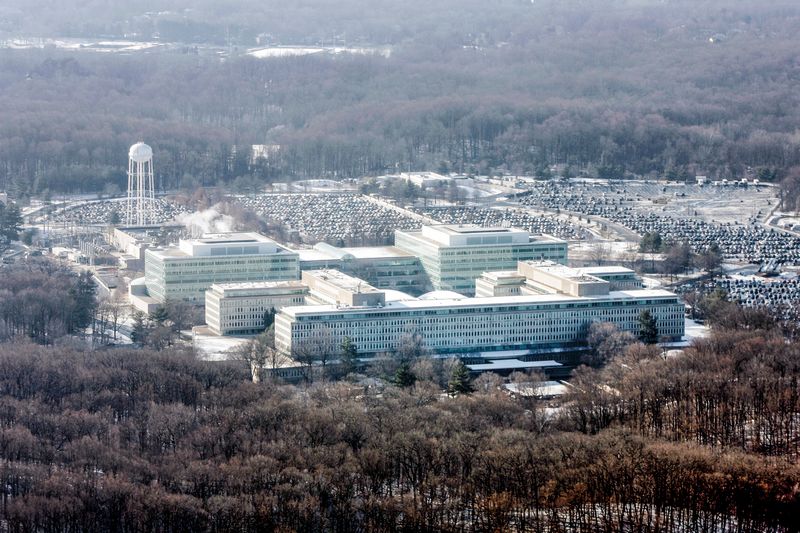By Sergey Naryshkin, Director of Russia’s Foreign Intelligence Service
In the Russian journal Natsionalnaya Oborona (National Defence), the chief of Russia’s foreign Intelligence Sergey Naryshkin has published a riveting essay on the 75th anniversary of the Central Intelligence Agency, which falls on Sunday.
It is an unusual gesture, especially in the middle of the hybrid war in Ukraine.
We have translated this text for those interested in hearing another voice on what we think we know about the CIA.
Read also: Check out our coverage on curated alternative narratives
Seventy-five years ago, on September 18, 1947, the National Security Act signed by President Harry Truman went into effect in the United States. This date is considered the birthday of the CIA, the Central Intelligence Agency, the country’s leading intelligence agency.

The history of this intelligence agency consists of numerous provocations, surrounded by a halo of myths, secrets, and scandals.
Any interstate conflict with explicit or implicit U.S. involvement does not go without mentioning this organization as the enforcer of Washington’s will.
The prototype of the CIA was the Office of Strategic Services (OSS), established in 1940 as a military-political intelligence agency and disbanded after World War II in 1946.
As Soviet intelligence officer Kim Philby wrote in his book ‘My Secret War’, British intelligence was actively involved in creating its American counterpart.
The reason was to take advantage of the rich resources of the United States to expand its intelligence capabilities.
Would the British regret go from being an experienced “big brother” in this intelligence coalition to a “junior” in leadership in a few years?
The CIA was established at the beginning of the Cold War era to conduct intelligence activities around the world to counter the existence and strengthening of the USSR’s role in the world, the formation of a bloc of socialist states, and the emergence of national liberation movements in Africa, Asia, and South America.
In the beginning, it was not without failures and mistakes. U.S. intelligence agencies completely slept through the Soviet nuclear project.
On September 20, 1949, the CIA’s analytical division predicted that the first Soviet atomic bomb would appear in mid-1953.
Embarrassingly, as they say, twenty-two days before the prediction was published, the Soviet Union conducted the first test of a Soviet atomic bomb.
Three days after the CIA analysts’ report, President Truman was forced to publicly admit that the Russians had already had an atomic bomb.
The first “successes” also occurred.
After the adoption of the law on nationalization of all Iranian oil fields in 1951 and the refusal of the international arbitration court to side with England and the U.S., preparations for the operation under the code name “Ajax” began on the personal orders of President Dwight Eisenhower.
Franklin Roosevelt’s nephew Kim Roosevelt, then head of the CIA’s Middle East Division, was put in charge.
By bribing Iranian military and government officials and making generous donations to the media, CIA officials organized unrest in the capital, leading to troops not loyal to Prime Minister Mohammad Mosaddegh entering Tehran.
Mosaddegh’s resignation allowed the return of U.S.- and U.K.-approved Shah Mohammad Reza Pahlavi to power in the country.
A MULTIDISCIPLINARY BEHEMOTH
In the early 1950s, the CIA began to evolve into an exceptional multidisciplinary service that, in addition to direct global intelligence activities, was tasked with monitoring and suppressing all political, economic, and military processes in all parts of the world that might threaten the global hegemony of the United States and its allies.
This shift in emphasis became particularly evident with the appointment of Allen Dulles as CIA director.
A. Dulles, as head of the CSS residence in Bern, Switzerland, from 1942-1945, had already been “found” in separate negotiations with the Nazis without the participation of representatives of the USSR (recall the vividly rendered episode in “Seventeen Moments of Spring” by Julian Semenov and the film of the same name).
A. Dulles brought aggressiveness and a lack of morality to the organization’s activities to achieve its goals.
The CIA counted coups d’état, direct military interventions, provocations of all kinds, the assassination of disagreeable politicians, terror, subversion, and bribery among its forces and means.
During this period, the image of the American secret service as “knights of the cloak and dagger” emerged.
U.S. President Lyndon Johnson, who was an opponent of organizing political assassinations abroad, referred to this “aspect” of the CIA’s work as the “goddamn murder society” (Goddamn Murder Inc.).

As Leroy Fletcher Prouty, a well-informed liaison officer between the Pentagon and the CIA, later noted when the results of the Vietnam adventure were discussed in the United States, A. Dulles’ concept provides for “10 percent conventional intelligence and 90 percent covert subversion.”
Thus, in April 1953, CIA director A. Dulles approved a project codenamed ‘MK Ultra’.
Its purpose was to gain control over the human mind through psychotropic substances and electrical effects.
This was done to obtain the so-called “truth serum”, which could be used during interrogations.
The project was led by CIA chief chemist Sidney Gottlieb.
Under ‘MK Ultra’, he set up more than a hundred subprograms with similar goals.
For example, experiments were conducted aimed at wholly or partially erasing a person’s memory while offering the possibility of correcting the quality of the personality or creating a completely new one.
For this purpose, people were anesthetized with LSD or hypnotically coded.
Unsuspecting military personnel or psychiatric patients suffering from depression or neurosis served as test subjects. The CIA continues to develop similar programs.
In this context, the testimony of former Venezuelan President H. Chavez is noteworthy, who in 2011 accused the CIA of developing and creating new types of biological, chemical, and electronic weapons and of using cancer dissemination technology to eliminate “undesirable” Latin American leaders.
Between 2000 and 2010, the disease was diagnosed not only in him (prostate cancer) but also in other Latin American presidents of that time – Argentina C. Fernández de Kirchner (thyroid cancer), Paraguay F. Lugo (lymphoma), and Brazilians L. Lula da Silva (throat cancer) and D. Rousseff (lymphoma).
The assassination of undesirables has become a hallmark of CIA covert operations.
Patrice Lumumba, prime minister of Congo, was assassinated. The former Belgian colony declared independence under his leadership in 1960.
Since the United States had its financial interests in the country, President Eisenhower tasked the CIA director with removing the “inconvenient” African leader.
Two years later, with the help of Belgian mercenaries, Fr. Lumumba was captured and killed, becoming a symbol of the African struggle for independence.
COUPS D’ÉTAT, POLITICAL ASSASSINATIONS, PROVOCATIONS
The CIA has had alternating successes and failures in terms of covert operations.
In 1954, the CIA staged a military invasion of Guatemala to overthrow President Jacobo Arbenz, and the operation was a success.
As part of the invasion, CIA mercenaries bombed Guatemalan cities with airstrikes. President Arbenz was forced to resign and was replaced by a pro-American incumbent.
In 1955, the CIA failed miserably to eliminate Chinese State Council Chairman Zhou Enlai, who Americans viewed as a “maniacal fanatic seeking world domination.”
Agents detonated a bomb on the plane where the premier was to fly to a conference of Asian and African heads of state in Indonesia, killing 16 passengers.
Zhou Enlai, however, was not on board. Dulles and Gottlieb then devised a plan to poison the Chinese politician but later had to abandon the project because they feared the CIA might be involved in the assassination.
In 1961, the CIA planned a military invasion of Cuba to overthrow the government of Fidel Castro.
On the morning of April 15, 1961, planes bearing Cuban Air Force insignia hit Cuban airfields, but Cuban military commanders replaced the aircraft with dummies in advance.
On the night of April 17, an amphibious landing began in the Bay of Pigs area. The operation did not immediately go according to plan, and the landing was foiled.
The U.S. suffered enormous damage to its image, and the CIA’s actions were not so brazen in the future.
The CIA’s program of reconnaissance flights over Soviet territory since 1956 can hardly be called a success.
For several years, U-2 reconnaissance planes were beyond the range of Soviet air defenses and could take unimpeded pictures of hidden objects.
The unique “10-10” unit, which flew on behalf of the CIA, was a NASA meteorological reconnaissance squadron.
On May 1, 1960, one of the U-2 aircraft was shot down over the Urals, and the United States accused the Soviet Union of destroying the research plane and the pilot.
So said President Dwight Eisenhower, who was assured by CIA leadership that Moscow would have no evidence.
However, the Soviets presented not only the plane’s wreckage and the spy equipment but also a live pilot, Francis Gary Powers, who spoke openly about what he was doing in the skies over the USSR and on whose orders.
As much as U.S. leaders in the 1960s and ’70s might deny the involvement of U.S. intelligence in organizing assassinations of political leaders of other countries, the revelation was not long in coming.
In 1975, a Senate committee headed by Senator Frank Church (a Democratic Party representative from Idaho) uncovered and confirmed facts about CIA involvement in contract assassinations and coups.
For example, the commission counted eight cases of attempted assassinations of Castro by CIA agents and mercenaries during 1960-1965.
The head of the State Security Department in the Cuban Ministry of the Interior, F. Escalante, who was responsible for the protection of Fidel Castro, officially stated that from 1959 to 1990 (for 30 years!), the service recorded 634 attempts to organize assassinations of the Cuban leader.

With insane tenacity, the CIA simply devised exotic methods to eliminate the commander.
They tried to kill him with suicide bombers, rogue agents, assassins from his inner circle, car and boat bombings of ships, boats, and submarine saboteurs, water tanks filled with tuberculosis bacilli, poisoned cigars, poison pills in his food, and much more.
Attacks were prepared in Cuba and during Castro’s visits to Chile, Peru, and Panama.
The CIA did not shy away from using American, Cuban, and Italian Mafiosi to organize anti-Cuban operations.
The 1973 coup d’état in Chile overthrew Salvador Allende’s government appeared to be an internal affair.
However, the brutality with which the Chilean military, led by General Augusto Pinochet, cracked down on dissenters in the country and slaughtered supporters of S. Allende betrayed the presence of an influential patron, allowing the military to act with impunity.
The CIA conducted operations under the code “Project FUBELT.”
These included destabilizing the situation in Chile, preparing a military coup by the top brass of the U.S. military academies, and providing propaganda support to the military junta that came to power.
After introducing a limited contingent of Soviet troops into Afghanistan in December 1979, the CIA began training and arming the Afghan opposition on behalf of the U.S. government.
The CIA actively worked to build an anti-Soviet coalition of countries, primarily from the Arab world.
Operation Cyclone, the CIA operation to fund and supply weapons to the Afghan mujahideen, began in 1980 with US$20-30 million and grew to US$630 million per year by 1987.
The CIA took every opportunity to inflict maximum damage on the Soviet Union, including economic damage.
CIA Director W. Casey personally contacted the King of Saudi Arabia and persuaded him to drastically increase oil production, which caused the world price of the Soviet Union’s main export commodity to drop almost threefold.
This was a significant loss to the Soviet Union’s budget and seriously affected further political developments in the USSR.
The CIA’s significant white-stitched provocations always came at “just the right time” and were linked to the U.S. government’s already prepared foreign policy or military actions.
For example, the invasion of Soviet airspace and the shooting down of the South Korean Boeing in 1983 was a propagandistic reason for President Ronald Reagan to announce another “crusade against communism.”
The policy of détente was abandoned, and a new round of arms race began.
BRUTALIZATION OF TERRORISTS, TORTURE, SECRET PRISONS
It is essential to know that CIA activities against the Soviet armies in Afghanistan and covert operations during and after the Iraq war caused many problems for the United States.
Osama Bin Ladin, the Saudi Arabian who the CIA was involved in working for Washington, quickly got out of control and became the ideological leader of the terrorist group Al-Qaeda*.
After the terrorist attack on the U.S. on September 11, 2001, he was credited with inspiring that terrorist act.
For another ten years, the CIA hunted the terrorist, only to eliminate him in a pompous special operation called “Neptune’s Spear” in Pakistan.
A similar story occurred with the Taliban. The U.S. fought the Taliban* in vain until 2021, suffered a crushing defeat, and left Afghanistan in disgrace.
After the end of military operations in Iraq, the CIA observed the emergence and rapid growth of a new terrorist organization, ISIS*, which the U.S. could not deal with alone or even in a coalition with more than three dozen allies.

It should be noted that in the late 1990s, the first testimonies appeared about secret prisons under the control of the CIA – secret objects outside the territory of the USA (especially near Russia – in Poland, Romania, and Lithuania).
In 2006, when it was already impossible to hide this information, U.S. President George Bush, Jr. officially recognized the existence of such prisons and declared that such special facilities were necessary for security reasons and that only particularly dangerous persons suspected of terrorism were held there.
It is not difficult to understand why these prisons had to be spread all over the world.
The location of these places, where prisoners were elaborately tortured and murdered, would be impossible on the territory of the United States.
CIA Director Michael Hayden’s statement in 2008 that the 18 used interrogation techniques were not torture but merely “harsher methods” sounded highly cynical.
It was not until 2009 that President Barack Obama signed an executive order banning the use of torture in interrogations.
SUBVERSION OF THE USSR, SUPPORT FOR UKRAINIAN NATIONALISTS
Another aspect of the CIA’s global and large-scale subversive activities against the USSR and later Russia is the “spread” that we can observe today.
While the CIA was helping to establish the first postwar German intelligence agency in the Western occupation zone-the Helen organization, which actively used the experience of Hitler’s intelligence services-it, launched a large-scale covert operation in cooperation with British intelligence to find a “useful” contingent for subversion against the USSR, especially in the Western occupation zones of Germany.
This operation from 1948-1949 was codenamed “Icon” by the CIA.
About seven hundred and fifty thousand USSR citizens, including two hundred and fifty thousand Ukrainians, were placed as displaced persons.
A few dozen organizations were also selected to bring together residents of Russia and the Eastern European states.
With this contingent, beginning in 1949, the CIA started to conduct a dozen programs and operations aimed at gaining intelligence and undermining the military, economic, and moral-psychological potential of the Soviet Union.
The CIA’s objectives concerning the USSR were:
- The mass deployment of agents from among the displaced persons returning to their homelands
- The establishment of agent networks for intelligence and subversive activities against Soviet formations abroad
- The support of nationalist movements in the Baltic states, western Belarus, and western Ukraine, using the ethnic natives of these republics living abroad for intelligence activities
- The recruitment, training, and deployment of agents from national minorities
Special attention was to be paid to the long-standing “Cartel” program, which ran until 1970.
Under this operation, the CIA trained agents among the refugees under the pretext of providing them with financial and material support, which they then passed on to the Soviet Union.
The CIA succeeded in controlling the leadership of the Ukrainian Revolutionary Rada (“Supreme Ukrainian Liberation Council”), with which the Ukrainian Insurgent Army (UPA*) headed by R. Shukhevich cooperated organizationally.
The Organization of Ukrainian Nationalists (OUN*), headed by S. Bandera, continued to be linked to the British SIS.
The rivalry between the two gangs was not about ideological differences but their masters’ money.
Virtually all leaders and top officials of the Ukrainian nationalists were committed to collaborating with the Nazis in one way or another. They were, therefore, fully controllable, primarily since the CIA and SIS conducted coordinated operations.
In the first phase of Operation Cartel, the CIA tasked agents dispatched to Ukraine with obtaining information on the situation in the republic, “the UPA national resistance forces, their capabilities, including possible options for their use in the event of military conflict with the USSR.”
In November 1950, Frank Wiesner, head of the CIA’s Political Coordination Directorate, reported to the Directorate that the UPA “operates in many parts of Ukraine, is popular with Ukrainians, and can field up to 100,000 fighters in the event of war.”
This information was at least five years old, and by 1950 the UPA was virtually ineffective. Small gangs hid in caves in the woods and made sporadic sorties.
Wiesner, however, was impressed by the fact that the UUN/UPA “managed to kill about 35,000 Soviet people from the end of World War II to 1951, including Communist Party members,” i.e., military personnel, Soviet and Party activists, rural intellectuals-teachers, doctors.
In the mid-1950s, the CIA was disappointed with the results of Operation Cartel and transformed it into a new operation – Operation Aerodynamic, conducted jointly with the intelligence services of Great Britain, Italy, and Germany.
Ukrainian nationalists were involved in the operation.
Non-profit organizations and the broadcasts of radio stations Nova Ukraina, Svoboda, and Svoboda Europe served the same purpose: massive propaganda and informational and ideological influence on Ukrainian citizens.
Aerodynamic ended in 1990 when the creation of non-independent Ukraine gave the CIA quite different opportunities for its activities.
* * *
Assessing the effectiveness of an intelligence agency is always relative. The U.S. Central Intelligence Agency, entering its 76th year of existence, has been and continues to be a zealous enforcer of the will of its country’s ruling circles.
Despite the significant changes, they continue to see themselves as the sole hegemon in a unipolar world.
As the name implies, it is an intelligence organization, but its focus is on carrying out provocative and subversive acts against sovereign states.
There will be no anniversary greetings and wishes.
Neither can there be any compromise in evaluating its role in history and its “services” to humanity.
_______________________________________________________________
* Al-Qaeda, the Taliban, and ISIS are terrorist organizations banned in the Russian Federation.
* UPA, OUN – extremist organizations banned in the territory of the Russian Federation.
Join us on Telegram: t.me/theriotimes

